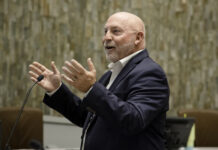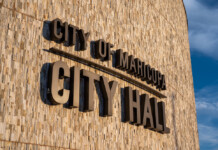
The Maricopa City Council debated extensively Tuesday evening whether or not to award a contract to Plateau Engineering to perform a study on a Quiet Zone for residents who live near the railroad tracks.
A railroad quiet zone is an area where locomotive engineers are not required to sound train warning horns as they approach an at-grade crossing.
“In Maricopa there are five at-grade highway-rail crossings: Ralston Road, John Wayne Parkway, Porter Road, White & Parker Road and Hartman Road. Federal regulations require engineers to use their horns on these types of crossings. Although it is at the discretion of the engineer, horns may be blown in an established quiet zone if and when there is the possibility of danger at the crossing.” This could include pedestrians or automobiles that would cause an accident, according to the city staff report.
“I can’t support it at this time, I think we have other fiscal priorities right now.” said Council member Alan Marchione. “This is only a study. It doesn’t do anything else for us.”
Under the current proposal, the study would cost the city $77,565. The cost was a concern to other council members as well, but the need for a Quiet Zone was not disputed.
“It is a quality of life issue,” said council member Marquisha Griffin. “However, the passing of the trains has increased, and it’s disruptive. Unless you live in the area, you don’t know how bothersome it is.”
Vice Mayor Edward Farrell added, “People quickly ask two things when they come here ‘what’s that smell and what’s that horn that goes on all night long?’”
City of Maricopa Transportation Coordinator Kellee Kelley informed the council that a study would be required before an actual Quiet Zone could be proposed for engineering design. The study would also have to be presented to and negotiated with the Federal Railroad Administration and Union Pacific before plans could be implemented.
Council member Carl Diedrich referenced a similar situation in Montana, quoting the cost of that study as $10,000.
In response, Transportation Manager Chris Salas said he didn’t think a topographical survey could be performed for that amount, as other parts of the contract would also include various design proposals, a risk index and negotiations with the railroads that Plateau Engineering would be performing.
Council decided not to act on the proposal at this time. They asked Salas to see what aspects of the contract could be internalized, removed and negotiated with Plateau Engineering prior to moving forward.
In a separate agenda item, Salas discussed the study and various proposals for traffic improvements on Honeycutt Road. An estimated 10,000 residents use the road daily. There is no traffic signal to allow for left turns onto SR 347, and currently the road is too narrow to accommodate multiple lanes.
Looking at temporary solutions, Salas proposed restriping, the use of Pershing Road for residents making left turns and making the entry from Honeycutt to 347 a right turn only. Long terms plans include a traffic signal and potentially purchasing more property to widen the road. The item was discussion only, and no action was taken.
In regard to the appeal of the awarded non-profit grants, council listened to the arguments of both Eco, Inc. and Chicanos Por La Causa. Gina D’Abella, executive director for Eco, Inc., proved the scoring system in the grant process was not accurate. Some council members did not score each grant, and the lack of accumulated points altered the results.
“Scores could be artificially inflated, and the applicants have a legitimate complaint,” said Mayor Anthony Smith, after hearing the appeal. Council agreed to look at the items in their pending budget review and tabled both appeals.
File photo

![City gave new manager big low-interest home loan City Manager Ben Bitter speaks during a Chamber of Commerce event at Global Water Resources on April 11, 2024. Bitter discussed the current state of economic development in Maricopa, as well as hinting at lowering property tax rates again. [Monica D. Spencer]](https://www.inmaricopa.com/wp-content/uploads/2024/04/spencer-041124-ben-bitter-chamber-property-taxes-web-218x150.jpg)
![3 things to know about the new city budget Vice Mayor Amber Liermann and Councilmember Eric Goettl review parts of the city's 2024 operational budget with Mayor Nancy Smith on April 24, 2024. [Monica D. Spencer]](https://www.inmaricopa.com/wp-content/uploads/2024/04/spencer-042424-preliminary-budget-meeting-web-218x150.jpg)




![Elena Trails releases home renderings An image of one of 56 elevation renderings submitted to Maricopa's planning department for the Elena Trails subdivison. The developer plans to construct 14 different floor plans, with four elevation styles per plan. [City of Maricopa]](https://www.inmaricopa.com/wp-content/uploads/2024/04/city-041724-elena-trails-rendering-218x150.jpg)
![Affordable apartments planned near ‘Restaurant Row’ A blue square highlights the area of the proposed affordable housing development and "Restaurant Row" sitting south of city hall and the Maricopa Police Department. Preliminary architectural drawings were not yet available. [City of Maricopa]](https://www.inmaricopa.com/wp-content/uploads/2024/04/041724-affordable-housing-project-restaurant-row-218x150.jpg)



![Maricopa’s ‘TikTok Rizz Party,’ explained One of several flyers for a "TikTok rizz party" is taped to a door in the Maricopa Business Center along Honeycutt Road on April 23, 2024. [Monica D. Spencer]](https://www.inmaricopa.com/wp-content/uploads/2024/04/spencer-042324-tiktok-rizz-party-flyer-web-218x150.jpg)

![Maricopa restauranteur makes Food Network connection [Namkeen Dhaba]](https://www.inmaricopa.com/wp-content/uploads/2024/04/439456716_377105198650519_7536248579664805896_n-100x70.jpg)


